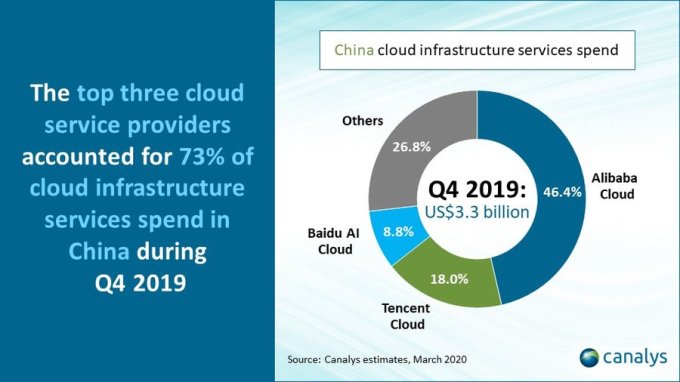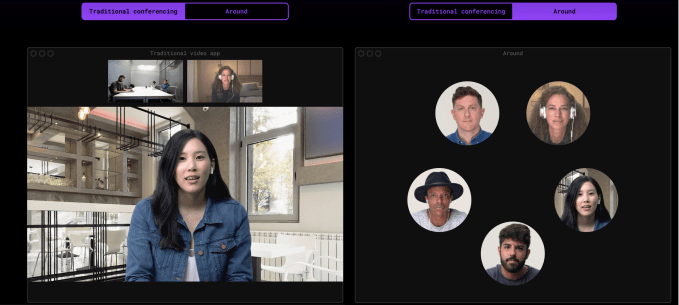Chinese cloud infrastructure market generated $3.3B in Q42019
Research firm Canalys reports that the Chinese cloud infrastructure market grew 66.9% to $3.3 billion in the last quarter of 2019, right before the COVID-19 virus hit the country. China is the second largest cloud infrastructure market in the world, with 10.8% share.
The quarter puts the Chinese market on a $13.2 billion run rate. Canalys pegged the U.S. market at $14 billion for the same time period, with a 47% worldwide market share.
Alibaba led the way in China, with more than 46% market share. Like its American e-commerce giant counterpart, Amazon, Alibaba has a cloud arm, and it dominates in its country much the same way AWS does in the U.S.
Tencent was in second, with 18%, roughly the equivalent of Microsoft Azure’s share in the U.S., and Baidu AI Cloud came in third, with 8.8%, roughly the equivalent of Google’s U.S. market share.

Slide: Canalys
Matthew Ball, an analyst at Canalys, says the fourth quarter numbers predate the medical crisis due to the COVID-19 outbreak in China. “In terms of growth drivers for Q4, we have seen the ongoing demand for on-demand compute and storage accelerate throughout 2019, as private and public organizations embark on digital transformation projects and start building platforms and applications to develop new services.”
Ball says gaming was a big cloud customer, as was healthcare, finance, transport and industry. He also pointed to growth in facial recognition technology as part of the smart city sector.
As for next year, Ball says the firm still sees big growth in the market despite the virus impact in Q12020. “In addition to the continuation of digital projects once business returns to normality, we anticipate many businesses new to using cloud services during the crisis will continue use and become paying customers,” he said. The cloud companies have been offering a number of free options to businesses during the crisis.
“The overall outcome of current events around the world will be that companies will assess their business continuity measures and make sure they can continue to operate if events are ever repeated,” he said.
Powered by WPeMatico
TikTok brings in outside experts to help it craft moderation and content policies
In October, TikTok href=”https://techcrunch.com/2019/10/15/tiktok-taps-corporate-law-firm-kl-gates-to-advise-on-its-u-s-content-moderation-policies/”> tapped corporate law firm K&L Gates to advise the company on its moderation policies and other topics afflicting social media platforms. As a part of those efforts, TikTok said it would form a new committee of experts to advise the business on topics like child safety, hate speech, misinformation, bullying and other potential problems. Today, TikTok is announcing the technology and safety experts who will be the company’s first committee members.
The committee, known as the TikTok Content Advisory Council, will be chaired by Dawn Nunziato, a professor at George Washington University Law School and co-director of the Global Internet Freedom Project. Nunziato specializes in free speech issues and content regulation — areas where TikTok has fallen short.
“A company willing to open its doors to outside experts to help shape upcoming policy shows organizational maturity and humility,” said Nunziato, of her joining. “I am working with TikTok because they’ve shown that they take content moderation seriously, are open to feedback and understand the importance of this area both for their community and for the future of healthy public discourse,” she added.
TikTok says it plans to grow the committee to around a dozen experts in time.
According to the company, other committee members include:
Rob Atkinson, Information Technology and Innovation Foundation, brings academic, private sector, and government experience as well as knowledge of technology policy that can advise our approach to innovation
Hany Farid, University of California, Berkeley Electrical Engineering & Computer Sciences and School of Information, is a renowned expert on digital image and video forensics, computer vision, deep fakes, and robust hashing
Mary Anne Franks, University of Miami Law School, focuses on the intersection of law and technology and will provide valuable insight into industry challenges including discrimination, safety, and online identity
Vicki Harrison, Stanford Psychiatry Center for Youth Mental Health and Wellbeing, is a social worker at the intersection of social media and mental health who understands child safety issues and holistic youth needs
Dawn Nunziato, chair, George Washington University Law School, is an internationally recognized expert in free speech and content regulation
David Ryan Polgar, All Tech Is Human, is a leading voice in tech ethics, digital citizenship, and navigating the complex challenge of aligning societal interests with technological priorities
Dan Schnur, USC Annenberg Center on Communication and UC Berkeley Institute of Governmental Studies, brings valuable experience and insight on political communications and voter information
Nunziato’s view of TikTok — of a company being open and willing to change — is a charitable one, it should be said.
The company is in dangerous territory here in the U.S., despite its popularity among Gen Z and millennial users. TikTok today is facing a national security review and a potential ban on all government workers’ phones. In addition, the Dept. of Defense suggested the app should be blocked on phones belonging to U.S. military personnel. Its 2017 acquisition of U.S.-based Musical.ly may even come under review.
Though known for its lighthearted content — like short videos of dances, comedy and various other creative endeavors — TikTok has also been accused of things like censoring the Hong Kong protests and more, which contributed to U.S. lawmakers’ fears that the Chinese-owned company may have to comply with “state intelligence work.”
TikTok has also been accused of having censored content from unattractive, poor or disabled persons, as well as videos from users identified as LGBTQ+. The company explained in December these guidelines are no longer used, as they were an early and misguided attempt to protect users from online bullying. TikTok had limited the reach of videos where such harassment could occur. But this suppression was done in the dark, unasked for by the “protected” parties — and it wasn’t until exposed by German site NetzPolitik that anyone knew these rules had existed.
In light of the increased scrutiny of its platform and its ties to China, TikTok has been taking a number of steps in an attempt to change its perception. The company released new Community Guidelines and published its first Transparency Report a few months ago. It also hired a global General Counsel and expanded its Trust & Safety hubs in the U.S., Ireland and Singapore. And it just announced a Transparency Center open to outside experts who want to review its moderation practices.
TikTok’s new Advisory Council will meet with the company’s U.S. leadership to focus on the key topics of importance starting at the end of the month, with an early focus on creating policies around misinformation and election interference.
Powered by WPeMatico
Sony finally unveils PlayStation 5 details
The PlayStation 5 warranted little more than a mention when it was introduced at CES back in January. Sony was planning a much bigger reveal in a few weeks at GDC in SF, but, well, COVID-19 happened. So here we are with a live-streamed version of the event, offering far and away the deepest dive into the next-gen console.
Lead system architect Mark Cerny kicked off a low key presentation to a small gathering of people — a direct response to on-going social distancing concerns. The event did, indeed go deep, at Cerny discussed how Sony enabled the 5GB/s SSD — the most requested new feature from developers. The system is said to potentially be nearly 100x faster than the PS4’s I/O.
The company also dumped a number of technical details for the forthcoming system, beginning to bring the PS5 up to speed with the Xbox Series X. Along with the new ultra-high-speed SDD, the system will sport a custom AMD GPU with ray tracing, and, as is Sony’s wont, 3D audio, for an improved multimedia home entertainment offering. As with the Xbox, there will be backwards compatibility — specifically with the PS4.
The CPU is an AMD’s Zen 2, with eight cores at 3.5GHz, while the GPU is based on AMD’s RDNA 2 architecture. The later offers 10.28 teraflops of compute power, by way of 36 CUs. There’s 16GB of memory on board, coupled with 825GB of solid state storage. Also on board is the new boost feature, designed to better regulate power consumption and heat on the system.
Per Cerny, rather than focusing on the temperature itself, the system monitors “the activities that the GPU and CPU are performing and set the frequencies on that basis .” The specifics of system cooling is one of several features the company is promising to reveal in further detail in a future “teardown” of the system.
3D audio was covered in the “Finding New Dreams” segment. Cerny pointed out that audio is often a bit of an afterthought on systems that are focused on graphics first. He added that it certainly applied to the PS4. The 5, meanwhile, is focused on bringing a version of PSVR’s immersive audio to the new system, adding things like presence and locality to the console. The company promises to offer much improved virtual surround sound, even on less advanced home stereo systems and headphones.
As with the new Xbox, the system is due out at the end of the year. Clearly Sony is just scratching the surface here. There’s still plenty of stuff left to announce between now and the holidays. Game play, anyone?
Powered by WPeMatico
Watch Sony unveil the PlayStation 5 live right here
A couple of days after Microsoft unveiled a ton of info about the Xbox Series X, Sony is about to do the exact same thing in a live video. Sony is hosting a live broadcast about the PlayStation 5 today at 9 AM PT, 12 PM ET, 4 PM GMT.
Lead system architect Mark Cerny will unveil the console’s architecture and what it means for both developers and gamers. We already know that the PlayStation 5 will be launched in late 2020. It’ll feature an eight-core AMD CPU, a custom AMD GPU with ray-tracing support and SSD storage.
The controller will support haptic feedback and adaptive triggers depending on what you’re doing in the game. But many details are still missing. Today’s announcement should answer some questions.
Powered by WPeMatico
Google’s Advanced Protection program for high-risk users now includes malware protection
Google is expanding the feature set for its Advanced Protection Program, a security offering that helps safeguard Google Accounts of those at risk for targeted attacks — like politicians, journalists, activists, business leaders and others. The program already provides an increased level of protection for these accounts by limiting access to data, blocking fraudulent account access, supporting the use of physical security keys and more. Today, Google is adding new malware protections to the program, as well.
For starters, those enrolled in the Advanced Protection Program will have Google Play Protect automatically enabled. This is Google’s built-in malware protection for Android that’s currently used to scan and verify 100 billion apps per day, Google notes. The system uses machine learning to automatically scan users’ devices and apps to check for harmful behavior and potential security issues. Now, this will be enabled for Advanced Protection Program members and will not be able to be shut off.
The program will also now limit users’ ability to install apps from outside the Play Store, where apps are now scanned for malware before approval. Those from outside the store can present a greater risk. Google will now prevent the download of non-Play Store apps on any devices enrolled in the Advanced Protection Program, with a few exceptions. Users will be able to install non-Play Store apps through other third-party app stores that may have shipped on your device from the device manufacturer. Others can be installed through the developer tool Android Debug Bridge. However, Google says non-Play Store apps that have already been installed won’t be removed and can continue to be updated.
Google launched its Advanced Protection Program in fall 2017, as an opt-in option for those who believe they’re at increased risk of online attacks. The program focuses on defending against phishing, locking down malicious apps, and fending off hackers. The trade-off is reduced convenience as there are additional steps to take during authentication and more limitations on what can be done. But the result is a safer, and free, way to increase the security of your account and device.
The new added protections will roll out gradually to accounts enrolled in the Advanced Protection Program on Android devices, to be later this year followed by new malware protections for Chrome, Google says. However, G Suite users won’t get these new protections now — instead, they’re offered through endpoint management, which helps secure devices belonging to mobile workforces.
Powered by WPeMatico
As Uber and Lyft continue to melt, the 2019 unicorn class loses its shine
You’d be excused for feeling that mid-2019 was in a different decade as far as venture-backed IPOs go.
Last year saw a number of successful flotations of venture-backed technology and technology-enabled companies, and most performed well after they began trading. But despite some early success, a number of the most famous 2019 IPOs have seen their valuations decline rapidly in ensuing quarters.
In some cases, once richly valued public unicorns are off more than twice the market’s recent declines, have given up all their gains earned as public companies, or fallen under their final private market valuations. It’s a stunning reversal for several of the most-lauded companies to come out of the venture capital machine in a decade.
Powered by WPeMatico
Manage remote teams with a transparent culture
Many companies have been designed to optimize productivity when everybody is in the office. As offices close due to the coronavirus outbreak, many people are experimenting with remote work at scale for the first time.
Employees have to learn what it means to work remotely — but managers also have to learn how to keep their teams on track. That’s why it’s interesting to talk about what it’s like to manage a remote team.
Some companies have chosen to give up on the office and work completely remotely. I interviewed Reedsy’s co-founder and CEO Emmanuel Nataf (pictured above, right) about the company’s current work culture. Reedsy operates a marketplace of professionals in the publishing industries: If you’re a writer, you can find editors, designers, marketing experts and more. And if you’re a freelancer in one of those fields, you can find clients.
The short answer: Managing a remote team takes discipline. The long answer is much more interesting as Reedsy has implemented many different processes to foster information transparency. The interview was translated from French and edited for clarity and brevity.
TechCrunch: What does it mean to have a remote culture?
Emmanuel Nataf: I think our case is quite specific. We’re 30 people and what we do cannot necessarily work for a bigger team. It works for smaller teams but maybe not above 50 people.
Powered by WPeMatico
All Raise CEO Pam Kostka on how the world isn’t ending
This isn’t the first economic downturn All Raise CEO Pam Kostka has been through.
“I was here during the dot-com bust and rush, and here during the financial fallout that happened, so we’re a little overdue for some corrective action in the market,” Kostka said. “While I’ve been through boom and bust cycles before, this one is more meaningful because life and death are associated with it.”
All Raise is a nonprofit that focuses on increasing diversity within venture capital, both from a decision-maker and a deal perspective. It recently released its annual report, and we covered how female-founded startups landed more deals than ever before in 2019, per PitchBook data.
After our piece looking at the numbers came out, however, some readers weighed in that our coverage missed the mark: In the headline, did we focus too much on progress and not enough on what is left to be done?
Because we’re both social distancing, I caught up with Kostka on the phone and got her take on how to report numbers around diversity without glossing over the work that remains to be accomplished. We also discussed how to stay optimistic during a downturn, potential innovation that might come out of COVID-19 and why diversity matters now more than ever.
Powered by WPeMatico
Quit Genius raises $11M Series A to expand into opioid, alcohol addiction treatment
Quit Genius, the YC-backed startup that uses cognitive behavioral therapy to help folks quit smoking and vaping tobacco products, has today announced the close of an $11 million Series A round.
The new funding was led by Octopus Ventures, with participation from Y Combinator, Startup Health and Triple Point Ventures.
Quit Genius was built by doctors — Yusuf Sherwani (co-founder and CEO), Maroof Ahmed (co-founder and COO) and Sarim Siddiqui (co-founder and head of product) — who met on the first day of medical school. They saw the terrible effects of smoking on patients’ health but didn’t see doctors giving those patients a clear path to quit smoking.
Cognitive behavioral therapy is seen as one of the more effective treatments for breaking addiction, helping patients focus on their thoughts, feelings and behaviors and understanding how one affects the others. The Quit Genius app helps users recognize when a negative thought or feeling pops up, and replace those triggering thoughts and emotions with more positive, healthier thoughts. This is done through various types of content, such as audio sessions, animated videos and interactive exercises.
The company also offers a device that can pair with the app to test users’ breath and help hold them accountable to their goal of quitting.
Quit Genius has already made headway with its smoking and vaping products, and is going to use the funding to expand into other types of addiction, such as alcohol and opioid addiction.
Alongside its consumer-facing product, Quit Genius also offers an enterprise product to businesses that are looking to foster a healthy workforce and also save money on healthcare for employees. Unlike most enterprise wellness programs that charge per person per year (regardless of utilization or engagement), Quit Genius only charges by engagement (employees who use the program) and offers a 25% quit rate guarantee.
In other words, if 25% of enrolled users don’t achieve their goal of quitting, Quit Genius will partially refund fees. Thus far, the company hasn’t had to do that, reports CEO Sherwani.
Sherwani added that the company has signed up 15 enterprise clients, split between self-insured employers and health plan providers.
Beyond the funding and expansion into other forms of addiction, Quit Genius is also trying to do its own part as the novel coronavirus pandemic spreads across the globe. Noting the high-risk status of smokers, Sherwani said that the company will offer its product for free to new sign-ups through April so that they can quit smoking immediately.
Founded by doctors, Quit Genius prioritizes efficacy. The company has enlisted independent research studies to show the success rate of its product, the results of which have been published in peer-reviewed journals. According to that research, more than 60,000 people have quit smoking, with a 53% quit rate, which is higher than other quit-smoking techniques.
The startup has raised a total of $13.6 million from investors listed above, as well as Eric Ries, Serena Williams’ Serena Ventures, Venus Williams and Instacart co-founder Max Mullen.
Powered by WPeMatico
Around is the new floating head video chat multitasking app
You have to actually get work done, not just video call all day, but apps like Zoom want to take over your screen. Remote workers who need to stay in touch while staying productive are forced to juggle tabs. Meanwhile, call participants often look and sound far away, dwarfed by their background and drowned in noise.
Today, Around launches its new video chat software that crops participants down to just circles that float on your screen so you have space for other apps. Designed for laptops, Around uses auto-zoom and noise cancelling to keep your face and voice in focus. Instead of crowding around one computer or piling into a big-screen conference room, up to 15 people can call from their own laptop without echo — even from right next to each other.

“Traditional videoconferencing tries to maximize visual presence. But too much presence gets in the way of your work,” says Around CEO Dominik Zane. “People want to make eye contact. They want to connect. But they also want to get stuff done. Around treats video as the means to an end, not the end in itself.”
Around becomes available today by request in invite-only beta for Mac, windows, Linux, and web. It’s been in private beta since last summer, but now users can sign up here for early access to Around. The freemium model means anyone can slide the app into their stack without paying at first.

After two years in stealth, Around’s 12-person distributed team reveals that it’s raised $5.2 million in seed funding over multiple rounds from Floodgate, Initialized Capital, Credo Ventures, AngelList’s Naval Ravikant, Product Hunt’s Ryan Hoover, Crashlytics’ Jeff Seibert, and angel Tommy Leep. The plan is to invest in talent and infrastructure to keep video calls snappy.
Not Just A Picturephone

Around CEO Dominik Zane
Around was born out of frustration with remote work collaboration. Zane and fellow Around co-founder Pavel Serbajlo had built mobile marketing company M.dot that was acquired by GoDaddy by using a fully distributed team. But they discovered that Zoom was “built around decades-old assumptions of what a video call should be” says Zane. “A Zoom video call is basically a telephone connected to a video camera. In terms of design, it’s not much different from the original Picturephone demoed at the 1964 World’s Fair.”
So together, they started Around as a video chat app that slips into the background rather than dominating the foreground. “We stripped out every unnecessary pixel by building a real-time panning and zooming technology that automatically keeps callers’ faces–and only their faces–in view at all times” Zane explains. It’s basically Facebook Messenger’s old Chat Heads design, but for the desktop enterprise.
Calls start with a shared link or /Around Slack command. You’re never unexpectedly dumped into a call, so you can stay on task. Since participants are closely cropped to their faces and not blown up full screen, they don’t have to worry about cleaning their workspace or exactly how their hair looks. That reduces the divide between work-from-homers and those in the office.
As for technology, Around’s “EchoTerminator” uses ultrasonic audio to detect nearby laptops and synchronization to eliminate those strange feedback sounds. Around also employs artificial intelligence and the fast CPUs of modern laptops to suppress noise like sirens, dog barks, washing machines, or screaming children. A browser version means you don’t have to wait for people to download anything, and visual emotes like “Cool idea” pop up below people’s faces so they don’t have to interrupt the speaker.

Traditional video chat vs Around
“Around is what you get when you rethink video chat for a 21st-century audience, with 21st-century technology,” says Initialized co-founder and general partner Garry Tan. “Around has cracked an incredibly difficult problem, integrating video into the way people actually work today. It makes other video-call products feel clumsy by comparison.”
There’s one big thing missing from Around: mobile. Since it’s meant for multitasking, it’s desktop/laptop only. But that orthodoxy ignores the fact that a team member on the go might still want to chime in on chats, even with just audio. Mobile apps are on the roadmap, though, with plans to allow direct dial-in and live transitioning from laptop to mobile. The 15-participant limit also prevents Around from working for all-hands meetings.
Competing with video calling giant Zoom will be a serious challenge. Nearly a decade of perfecting its technology gives Zoom super low latency so people don’t talk over each other. Around will have to hope that its smaller windows let it keep delays down. There’s also other multitask video apps like Loom’s asynchronously-recorded video clips that prevent distraction.
With coronavirus putting a new emphasis on video technology for tons of companies, finding great engineers could be difficult. “Talent is scarce, and good video is hard tech. Video products are on the rise. Google and large companies snag all the talent, plus they have the ability and scale to train audio-video professionals at universities in northern Europe” Zane tells me. “Talent wars are the biggest risk and obstacle for all real-time video companies.”
But that rise also means there are tons of people fed up with having to stop work to video chat, kids and pets wandering into their calls, and constantly yelling at co-workers to “mute your damn mic!” If ever there was a perfect time to launch Around, it’s now.

“Eight years ago we were a team of locals and immigrants, traveling frequently, moving between locations and offices” Zane recalls. “We realized that this was the future of work and it’s going to be one of the most significant transformations of modern society over the next 30 years . . . We’re building the product we’ve wanted for ourselves.”
One of the best things about working remotely is you don’t have colleagues randomly bugging you about superfluous nonsense. But the heaviness of traditional video chat swings things too far in the other direction. You’re isolated unless you want to make a big deal out of scheduling a call. We need presence and connection, but also the space to remain in flow. We don’t want to be away or on top of each other. We want to be around.
Powered by WPeMatico